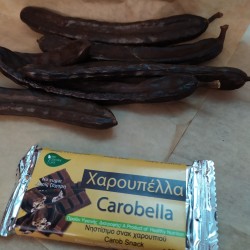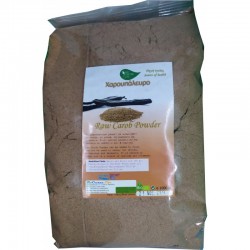Carob
The production of biocretanlife products comes from our own biologically certified crops but also from the cooperation with other Cretan producers, with the best production conditions.
Health Benefits
Carob is up to 8% protein. It contains Vitamins A, B, B2, B3 and D. It is high in Calcium, phosphorus, pottasium, Magnesium and contains Iron Manganese, and Copper. We are offering carob products in different shapes and sizes.
Our final products correspond to the regulations of the European Union and received the bio qualification in Greece and in the European Eunion from TUV Austria, the Organisation of Testing and Certification of Organic Products.
Carob is a healthy alternative to cocoa.
Carob, unlike cocoa, is free from caffeine and theobromine, that are both stimulants.
Also, carob does not contain amine and phenylethylamine which can trigger migraines and allergic reactions.
It has no oxalic acid which prevents the body using calcium and zinc.
Oxalic acid in cocoa may be connected to the onset of spottiness in some teenagers eating larger amount of chocolate.
Carob is gluten free thus it is a great treat for those who suffer from a condition called celiac disease.
All of our carob products are gluten free, high in protein and low in fat.
They contain twice as much calcium than dairy milk.
They are rich in Vitamins A, B, B2, B3 and D and offer many traces of minerals.
They aid digestion, lower cholesterol levels, relieve diarrhoea in infants and adults, relieve asthma (whether or not caused by allergies), act as an expectorant, are caffeine free, ease coughs and colds, contain Gallic acid, and help prevent polio.
Also, carob is known to increase libido and number of sperm cells.
Carobs have been a favorite food of Cretans for many years. But where are the locusts in Crete and how productive are they? Why is carob "the Black Gold of Crete"?
Carob is one of the most common trees in Crete. It is planted everywhere, even on sidewalks in cities, because it has dense shade and requires zero care. The hard locusts (or Xylokeraties) thrive in arid and rocky areas and are quite far from each other. We will find Carob in all the prefectures of Crete, on mountain slopes, in ravines, among the olive trees. Many years ago, the dry parts of Crete were ideal areas for the cultivation of locusts for the production of animal feed, and so today it is an important part of the island's identity. Statistical research has shown that of the approximately 15,000 tons of locusts in our country, 80% is produced in Crete and is distributed approximately equally in the four prefectures. The production of biocretanlife products comes from our own biologically certified crops but also from the cooperation with other Cretan producers, with the best production conditions.
Ancient Greek carob tree was known to the ancient Greeks who cultivated it for its fruits as food for humans and animals. An anecdotal source even states that the 'lotus' eaten by lotus eaters in the Odyssey was in fact locusts. In classical antiquity, the philosopher and successor of Aristotle, Theophrastus the Ephesian (372-287 BC) informs us that in Ionia the tree was called "Keronia" and its fruit "Egyptian fig". He even recorded a detailed description of the locust tree. Notice that the fruits emerge from the trunk of the tree, as the flowers always grow in the axils of the leaves or directly from the old branches. During the Hellenistic years, the carob tree was also called "Keratea" (K5). Pliny the Elder (23-79 AD) refers to the sweet carob beans as food for the pigs.
Egypt, Ancient Rome, Israel 🡪 There is evidence that the ancient Egyptians used carob. Carob pods and seeds have been found in Egyptian Tombs, while even today in Egypt they eat the dried pod as a snack and make a special alcoholic beverage by fermentation. The Romans also ate carob peels for their natural sweetness when they were still green and fresh. Jews and Muslims still eat locusts during the feast of Biswat, or during Ramadan, respectively. The Arabs considered them excellent emollients for chest infections and recommended them to patients with chronic bronchitis.
Bible 🡪 According to the Bible, John the Baptist ate locusts while he was in the wilderness. Later, Europeans called the carob tree a "St. John's bread / tree", and in several European languages we find the carob tree as "Saint John's bread / tree" (English), "Johannisbrot" (Swedish) or "Johannisbrotbaum" (German). ). Also, from the parable of the Prodigal Son we conclude that locusts were considered somewhat mediocre food for man as they served mainly as food for the pigs of the stable where the Prodigal Son went to work when he was hungry and destitute.












